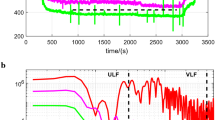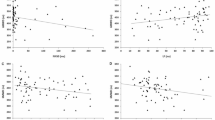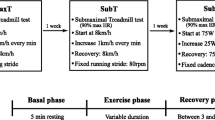Abstract
The purpose of this study was to determine if patients with the chronic fatigue syndrome have less vagal power during walking and rest periods following walking, in comparison to a group of healthy controls. Eleven patients (ten women and one man) who fulfilled the case definition for chronic fatigue syndrome modified to reduce heterogeneity and eleven healthy, but sedentary, age- and sex-matched controls walked on a treadmill at 2.5 mph four times each for 4 min duration. Between each period of walking, subjects were given a 4-min seated rest period. Vagal power, a Fourier-based measure of cardiac, parasympathetic activity in the frequency range of 0.15 to 1.0 Hz, was computed. In each period of walking and in one period of rest, patients had significantly less vagal power than the control subjects despite there being no significant group-wise differences in mean heart rate, tidal volume, minute volume, respiratory rate, oxygen consumption or total spectrum power. Further, patients had a significant decline in resting vagal power after periods of walking. These results suggest a subtle abnormality in vagal activity to the heart in patients with the chronic fatigue syndrome and may explain, in part, their post-exertional symptom exacerbation.
Similar content being viewed by others
References
Wilson A, Hickie I, Lloyd Aet al. Longitudinal study of outcome of chronic fatigue syndrome.BMJ 1994;308: 756–759.
Pagani M, Lucini D, Mela GS, Langewitz W, Malliani A. Sympathetic overactivity in subjects complaining of unexplained fatigue.Clin Sci 1994:87: 655–661
Bou-Holaigah I, Rowe PC, Kan J, Calkins H. The relationship between neurally mediated hypotension and the chronic fatigue syndrome.JAMA 1995;274: 961–967.
Schondorf R, Low PA. Idiopathic postural orthostatic tachycardia syndrome: An attenuated form of acute pandysautonomia?Neurol 1993;43: 132–137.
Montague TJ, Marrie TJ, Klassen GA, Bewick DJ, Horacek BM. Cardiac function at rest and with exercise in the chronic fatigue syndrome.Chest 1989;95: 779–784
Riley MS, O'Brien CJ, McCluskey DR, Bell NP, Nicholls DP. Aerobic work capacity in patients with chronic fatigue syndrome.BMJ 1990;301: 953–956.
Sisto SA, Tapp W, Drastal Set al. Vagal tone is reduced during paced breathing in patients with the chronic fatigue syndrome.Clin Auton Res 1995;5: 139–143.
Akselrod S, Gordon D, Ubel FA, Shannon DC, Barger AC, Cohen RJ. Power spectrum analysis of heart rate fluctuation: a quantitative probe of beat-to-beat cardiovascular control.Science 1981;213: 220–222.
Holmes GP, Kaplan JE, Gantz NMet al. Chronic fatigue syndrome: a working case definition.Ann Intern Med 1988;108: 387–389.
Schluederberg A, Straus SE, Peterson Pet al. Chronic fatigue syndrome research. Definition and medical outcome assessment.Ann Intern Med 1992;117: 325–331.
Marcus S, Robins LN, Bucholz K. Quick Diagnostic Interview Schedule 3R version 1. St Louis, MO: Washington University School of Medicine, 1990.
Natelson BH, Johnson SK, DeLuca Jet al. Reducing heterogeneity in the chronic fatigue syndrome: A comparison with depression and multiple sclerosis.Clin Infect Dis 1995;21: 1204–1210.
Fukuda K, Straus SE, Hickie I, Sharpe MC, Dobbins JG, Komaroff A. the International Chronic Fatigue Syndrome Study Group. The chronic fatigue syndrome: a comprehensive approach to its definition and study.Ann Intern Med 1994;121: 953–959.
Hirsch JA, Bishop B. Respiratory sinus arrhythmia in humans: how breathing pattern modulates heart rate.Am J Physiol Heart Circ Physiol 1981;241: H620-H629.
Brown TE, Beightol LA, Koh J, Eckberg DL. Important influence of respiration on human R-R interval power spectra is largely ignored.J Appl Physiol 1993;75: 2310–2317.
Shin S, Tapp WN, Reisman SS, Natelson BH. Assessment of autonomic regulation of heart rate variability by the method of complex demodulation. IEEETransac Biomed Engin 1989;36: 274–283.
Cleveland WS, Grosse E, Shyu WM. Local regression models. In: Chambers JM, Hastie TJ, eds.Statistical Models in S. Pacific. Grove, CA, Wadsworth & Brooks/Cole Advanced Books & Software, 1992; 309–376.
Pagani M, Lombardi F, Guzzetti Set al. Power spectral analysis of heart rate and arterial pressure variabilities as a marker of sympatho-vagal interaction in man and conscious dog.Circ Res 1986;59: 178–193.
Cannon WB, Rosenblueth A.Autonomic Neuro-Effector Systems. New York: The Macmillan Co, 1937.
Freeman R, Saul JP, Roberts MS, Berger RD, Broadbridge C, Cohen RJ. Spectral analysis of heart rate in diabetic autonomic neuropathy.Arch Neurol 1991;48: 185–190.
Aharon-Peretz J, Harel T, Revach M, Ben-Haim SA. Increased sympathetic and decreased parasympathetic cardiac innervation in patients with Alzheimer's disease.Arch Neurol 1992;49: 919–922.
Paul JP, Arai Y, Berger RD, Lilly LS, Colucci WS, Cohen RJ. Assessment of autonomic regulation in chronic congestive heart failure by heart rate spectral analysis.Am J Cardiol 1988;61: 1292–1299.
Natelson BH, Cohen JM, Brassloff I, Lee H-J. A controlled study of brain magnetic resonance imaging in patients with the chronic fatigue syndrome.J Neurol Sci 1993;120: 213–217.
DeLuca J, Johnson SK, Natelson BH. Information processing efficiency in chronic fatigue syndrome and multiple sclerosis.Arch Neurol 1993;50: 301–304.
Costa DC, Tannock C, Brostoff J. Brainstem perfusion is impaired in chronic fatigue syndrome.Q J Med 1995;88: 767–773.
Goldsmith RL, Bigger JT, Jr, Steinman RC, Fleiss JL. Comparison of 24-hour parasympathetic activity in endurance-trained and untrained young men.J Am Coll Cardiol 1992;20: 552–558.
Furlan R, Piazza S, Dell'Orto Set al. Early and late effects of exercise and athletic training on neural mechanisms controlling heart rate.Cardiovasc Res 1993;27: 482–488.
Allen MT, Crowell MD. The effects of paced respiration on cardiopulmonary responses to laboratory stressors.J Psychophysiol 1990;4: 357–368.
Sakakibara M, Takeuchi S, Hayano J. Effect of relaxation training on cardiac parasympathetic tone.Psychophysiol 1994;31: 223–228.
Author information
Authors and Affiliations
Rights and permissions
About this article
Cite this article
Cordero, D.L., Sisto, S.A., Tapp, W.N. et al. Decreased vagal power during treadmill walking in patients with chronic fatigue syndrome. Clinical Autonomic Research 6, 329–333 (1996). https://doi.org/10.1007/BF02556303
Received:
Accepted:
Issue Date:
DOI: https://doi.org/10.1007/BF02556303




